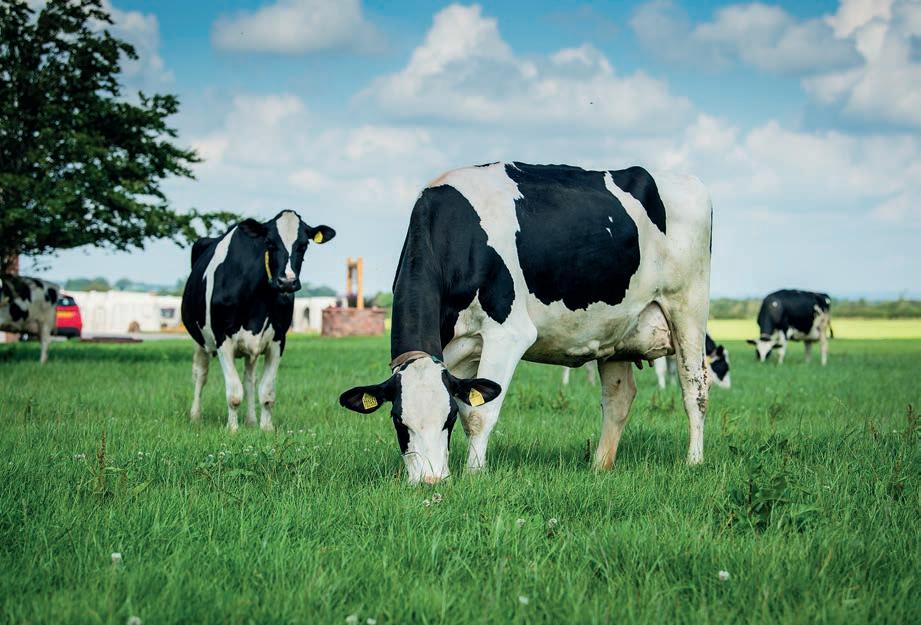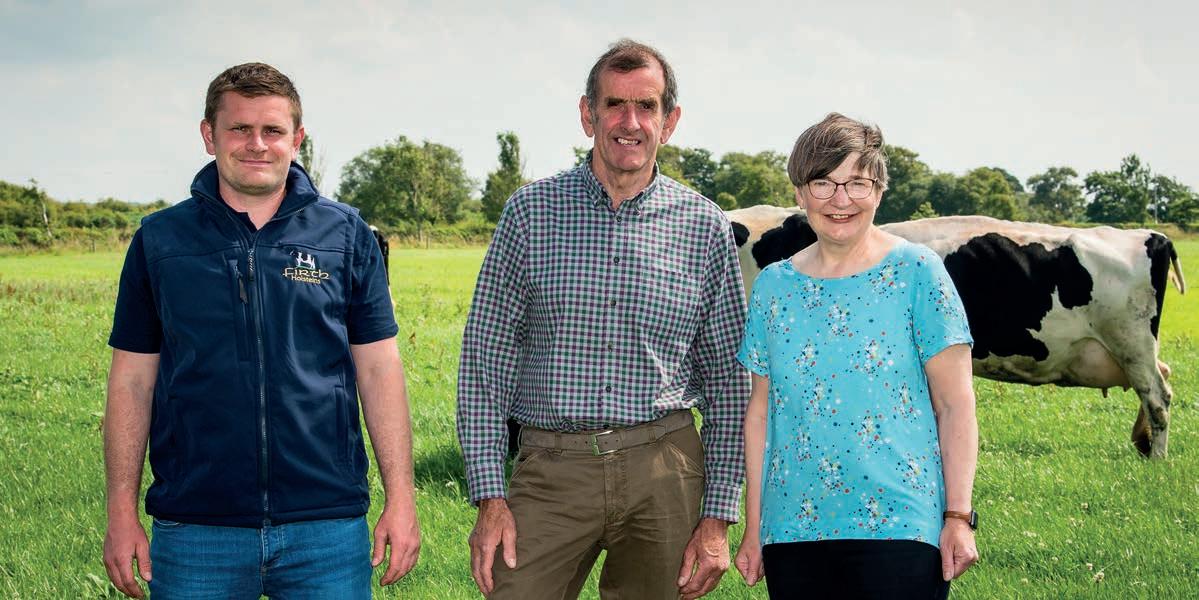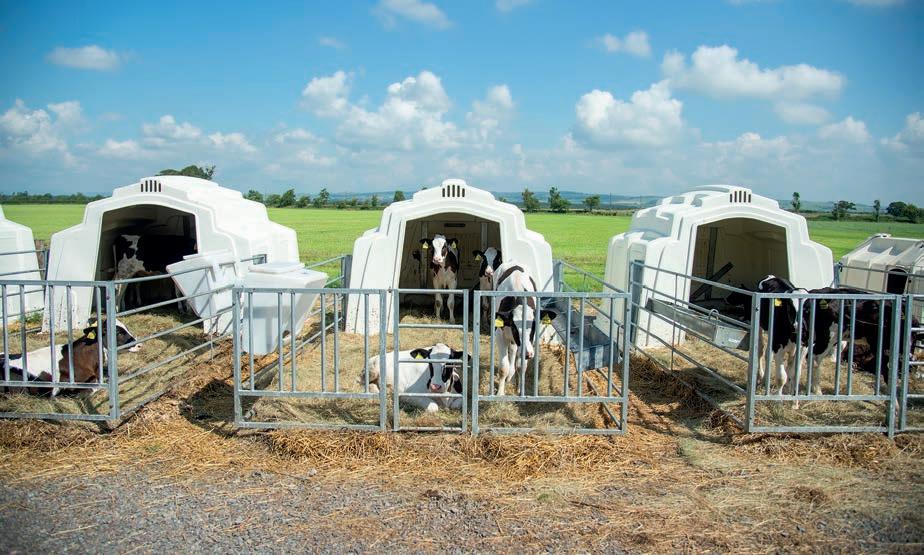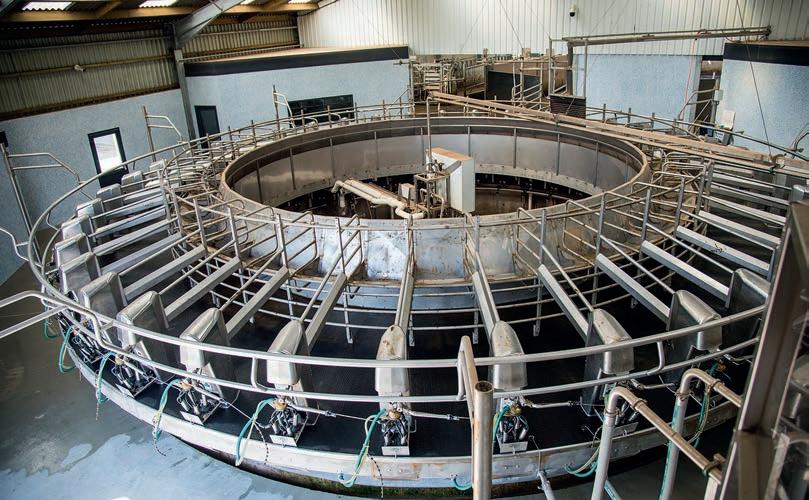
7 minute read
ON FARM
Holstein UK president John Jamieson made a switch to organic milk production in 1999 and has just completed a five-year plan to modernise the facilities on his farm near Dumfries. Wendy Short reports. Modernisation plan for organic Holstein herd
The 240 Holstein cows at the Jamieson family’s Upper Locharwoods Farm produce a 10,000kg yield from a simple organic diet of silage and home-grown grains, supplemented with a protein mix which is fed in the parlour. e unit is run by John Jamieson and his wife Helen, together with their son Graham. e Firth herd, which calves all year round and is milked with a 12-hour interval starting at 3.30am, is housed from early October until mid-March.
Milk production totals 2.2 million litres at 4.22% bu erfat and 3.02% protein, with milk sold to Muller.
e ve-year modernisation plan included the 2020 replacement of the 20:20 herringbone with a GEA T8900 rotary parlour, which is one of the rst models to have been installed in the UK.
Another new feature is 180place accommodation which has been designed speci cally for sand-bedded cubicles, although the transition group continues to be kept on sawdust-topped ma resses.
Usage
John says: “A fully sand-bedded cubicle can require up to six tonnes of sand per cow per year, but we have cut usage to 1t by applying a thin layer over ma resses.
“A sla ed se lement channel runs through the shed and the sand is removed twice a year and spread on the land.” e sand bedding has addressed the drive to minimise the incidence of mastitis, he adds.
“As an organic farm, we must consider antibiotic usage as a last resort. If antibiotics do have to be administered, we face a double milk withdrawal period compared with a conventional unit.
“Our policy to use a teat sealant as standard across all dry cows works well and the sand bedding has been highly bene cial in reducing the number of mastitis cases, with the current average for somatic cell count at 122,000. is reduced reliance on the use of antibiotics continues to keep us focused.” e dairy unit also bene ts from a 50kW solar panel system and a 200kW biomass boiler. Another element of the improvement was the installation of one million gallons of additional slurry storage; it has improved utilisation by allowing for more exible application times.
Genomic sires
Sexed semen from genomic sires is used exclusively. Type classi cation is part of the Holstein Complete Package from Holstein UK and the unit currently has 34 EX and 115 VG-scored females. ese come from families including Vale, Rudy, Missy and Roxe e. Lack of time prevents showing, but the herd has enjoyed previous success at AgriScot, as well as the National Holstein, Royal Highland and Great Yorkshire shows.
In the early days, Hanoverhill Starbuck had a signi cant in uence on the herd and subsequently animals and embryos were purchased from some of the top herds in North America and the UK. e lower end and repeat breeders are put to an Aberdeen-Angus and their cross-bred calves are sold at four weeks to a local nisher. e aim is to calve heifers at 24 months.
All replacement calves are reared in hutches and fed pasteurised whole milk until 12 weeks and it has been found that giving calves warm water twice a day has improved growth rates.
John says: “ ere is no doubt that the biggest step forward within the dairy industry in recent times has been the introduction of sexed
Some of the milking herd grazing.
semen. e technique is a great innovation and has li ed the burden of unwanted dairy bull calves on our farms.
“Our goal has always been to breed cows which have strength, good locomotion with high, wide rear udders and a wide rump.
“Another desired trait is low pin se ings, which aid fertility. ere is a great selection of genetics within the breed and it is a question of picking the one which suits the farming system and the producer’s criteria.” e herd is not subject to a formal health scheme, but the cows are monitored for a range of diseases through the Ca le Information Service (CIS). e milk is routinely tested for leptospirosis and IBR, while cows are individually tested for Johne’s every three months and calves are ear-notched for DNA and bovine viral diarrhoea control.
Winter cereals
Some 24 hectares (59 acres) of the 275ha (680-acre) farm total are dedicated to winter cereal crops, with a similar acreage sown with spring cereals. e grain balances the grass silage and protein mix by providing starch for the total mixed ration, says John.
He says: “As an organic farm we do not have as many tools in our toolbox as a conventional farm when it comes to formulating diets.
“We have no access to organic by-products, so we tend to stick to a simple system. Our herd is proof that the Holstein can convert forage e ciently and we are always in the

Left to right: Graham, John and Helen Jamieson.

UP TO 99
% LESS YEASTs & MOULDS TAKE CONTROL OF MAIZE SILAGE QUALITY
MAGNIVA crop and condition speci c inoculants are formulated for the multiple challenges of Maize silage.
MAGNIVA PLATINUM MAIZE inoculants contain a unique combination of proven bacteria and enzymes providing complete exibility on clamp opening times, in addition to:
UP TO 250
mj/t MORE energy
UP TO 15
% MORE DM
See MAGNIVA’s e ect in this short video

top three organic herds in the country with our costings.” e average cow weighs about 650kg, but the breeding policy is moving towards a slightly smaller animal.
John says: “If we can keep a smaller cow which requires less maintenance but can match our current yields then it makes sense to go in that direction; research shows it is possible.
“We have a responsibility to continue to look a er the environment and I think we must all do our bit, although we also have the added challenge of feeding a growing population.
“Organic farming has been an interesting journey and we have learned a lot about managing the soil so that the soil in turn looks a er the crops.” e family has farmed at Upper Locharwoods for 70 years and changed from pedigree Ayrshires to Holsteins when the Firth Herd was rst registered in 1982.
John says: “I worked in Canada for a spell and came home very impressed with the Holstein. I felt it was the breed for the future and my father was good enough to support my decision to grade up the Ayrshires.
“Grading up the herd allowed us to retain the strong cow families we had established over the years.”
Having invested in facilities to improve production e ciency, the only potential change in the near future would be to slightly increase cow numbers to 300 cows, he says.
Meanwhile, he is enjoying his term as Holstein UK president. e role normally lasts for 12 months, but he agreed to stand for an additional year, due to the restrictions imposed by Covid-19. is year’s celebrations included a visit to Upper Locharwoods, where visitors appraised the cow families and took a great interest in the new dairy unit.
John says: “ e organisation is doing well and we have about 6,000 members, which includes a strong Holstein Young Breeders movement.
“ e sta members are eagerly anticipating our imminent move into new headquarters. Our location will remain in Telford, Shropshire, but the new building will also accommodate CIS and the National Bovine Data Centre.
“In my opinion, the Holstein as a breed is in a strong position to face whatever the farming future holds.”
Farm facts
rDuring summer, the herd is grazed on a paddock system rFive cuts of ryegrass and clover silage are taken each year rConcrete cow tracks were installed three years ago and they are considered a very worthwhile investment rLand is a heavy, droughtresistant loam at close to sea level in a high rainfall area, all of which makes for good grass production rThe farm includes 40 hectares (100 acres) of site of special scientific interest peat land which is only lightly grazed; it is believed its value may be more fully appreciated in the future
The farm’s 40-point rotary parlour.
Twelve-week-old heifer calves in hutches.











